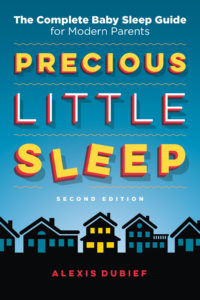There are many big challenges with a newborn baby: figuring out the soothing thing, unbreakable swaddling, learning how to feed a baby, wrestling them to sleep, etc. Usually by the 3 month mark, those hurdles have all been conquered. You are now a confident parent rocking the baby play groups, champion of navigating the grocery store with a baby, and chilling with other parents at Starbucks.
Champion parents will also have already read Sleeping Through the Night Part I. It’s long and not particularly funny but it will explain the single most important thing you need to know to stay the course towards sleeping all night long. Go read it and then come back when you’re done (I’ll wait).
Now you know why it is so critical that you teach your baby to fall asleep without you (nursing, rocking, cuddling, etc.).
Note: A small percentage of babies will continue to sleep well even if they are being nursed, rocked, etc. until they are fully asleep. If you are the parent of an older baby who is sleeping like a champ (then you probably aren’t looking for answers for sleep problems on the internet but….) then you may have one of these rare babies who CAN be nursed, rocked, etc. until they are completely asleep without any problems.
YET. Very few kids will sleep this way successfully forever.
Putting Your Baby Down Awake
By the time your baby is ~6 months old (give or take 2 months) you need to have figured out how to put your baby down awake and have them fall asleep without your assistance.
If you have already mastered the ability to put your baby down to sleep awake, good for you! Now stop gloating and please go away, the rest of us are still struggling with this.
Every parent has read about “drowsy but awake”. This is not the goal. “Drowsy but awake”…

The goal is independent sleep and that means your child falls asleep without your direct intervention. Falling asleep is a process – we’re not “awake” then “asleep”. There is a journey of falling asleep and your kiddo needs to take this journey independently. I get it – this is different from how you’ve been doing things and it’s hard to look at their baby and conceptualize that they are, indeed, capable of doing anything on their own much less sleep. But they are!
How to Put Baby Down Awake
There are many approaches to foster independent sleep. I detail 7 methods along with how to identify which will work best for your child based on age and temperament in the book. If you’re serious about helping your child learn to fall asleep without you this resource is a must. But here is a brief summary of some approaches.
Make it Gradual
This is one of the most challenging methods and the easiest to mess up so let me say this first: take a good look at you and your partner. How are you guys doing? If you are ground to a pulp (sleep deprived, just recovering from the flu, stressed out, have little/no support) then skip this method, it’s not for you. On the other hand if you’re feeling fairly chipper, read on.
Basically your job is to take whatever technique you are using to help your baby sleep and gradually make itty bitty modifications (typically over many weeks) to slowly wean baby off this technique.
Some people assume “gradual” = “no tears.” So let’s take a step back and consider – why is your baby upset when you make changes? Because it’s harder to do things a new way. Typically for the whole of their lives we’ve done it one way and now we’re doing things differently and different = uncomfortable. This is not just true for babies, change is hard for all people! And their feeling about change is, “Hard pass!” OK baby we hear you!
This doesn’t mean that change is impossible or that your baby is incapable.
So back to gradual approaches – most parents want to start here and that’s fantastic! Realistic goals are:
- Your child will still have their feelings about change and that’s ok!
- It will take longer to see significant results (weeks vs. days).
- It’s a higher level of difficulty – sneaky lingering sleep associations may persist depending on how you approach things.
- Chance of success decreases as baby gets older. This is absolutely a “younger is better” situation.
For these reasons I suggest this method is kinda challenging. Thus my initial question – how beat up are you? If you and your partner are shuffling zombies your chance of success is low. You are welcome to try, and I encourage you to come up with a plan and give it a go. But don’t beat yourself up if, after a few weeks, you’re feeling frustrated by the lack of success.
Note: This method can be extraordinarily challenging if your baby uses a pacifier to fall asleep. Most pediatricians recommend loosing the pacifier by 6 months of age because this little tool which was so helpful for baby sleep when they’re little can become the bane of your existence when they’re older. I have never found a gradual way to remove the pacifier as they seem very binary – either you give them a paci or you don’t.
Double Take
Help your baby fall asleep using your usual method and put them into their bed. Once they’re down, wake them slightly – enough so they look at you in a focused way (they need to actually be awake). Then let them fall back to sleep on their own. “But they won’t just fall back to sleep!” you say. Possibly. But often this works surprisingly well!
Sleep Training
1. If your baby is older than 6-8 months old and…
2. they’re sleeping poorly (waking up frequently throughout the night, taking short naps, fighting naps, etc.) and…
3. you’ve tried other techniques, or for whatever reason, they didn’t suit, it’s likely time to SLIP into sleep (Sleep Learning Independence Plan – described in length in the book).
Sleep training is a big topic and with lots of information about how, when, why, and why not. But I want to make a quick distinction here – sleep training is about learning how to fall asleep independently. And frankly, if done right, it’s incredibly effective. It out is NOT about night weaning. Parents often conflate these two issues.
If your baby has been consuming lots of milk/formula all night long they will still need and expect to eat at night. Changing how they fall asleep at bedtime establishes the foundation for effective night weaning but is not, on its own, night weaning.
The key takeaway here is there are multiple approaches and each has situations/ages where they’re the best fit. The key is to find a strategy that works for your family and your unique situation so that you can successfully help your little one learn to fall asleep a new way. Because they are capable. Our babies are amazing!

